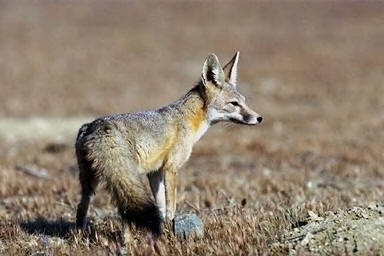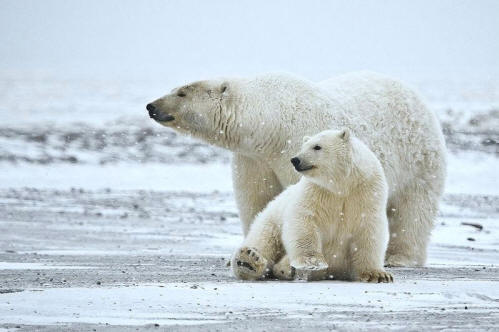< BACK |
NEXT> |
Manitoba Scenery Photo Tour
Manitoba Wildlife: Mammals
Of course, this is just a small sampling of Manitoba wildlife. But it gives you a taste for what you might see if you visit.
Photo: Arctic FoxThe Arctic fox is about the size of a large house cat, making it the smallest wild canid (foxes and wolves) found in Canada. The Arctic fox lives in the Arctic, including the northern parts of Manitoba, Canada. They are normally found where seals and polar bears are present in and on ice floes. The Arctic fox has the warmest pelt of any animal found in the Arctic. They can endure temperatures as low as -50ºC before their metabolisms increase to provide extra warmth. Their feet are covered with fur (like a rabbit) and their ears and muzzles are small and rounded. All of these attributes reduce the amount of heat lost to help keep them warmer. |
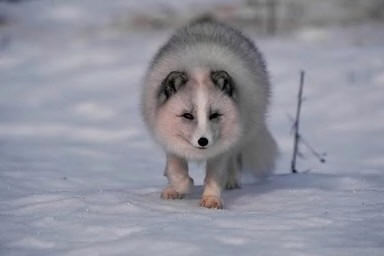 |
 |
Photo: BeaverBeavers can be found in streams and rivers in every province of Canada. Much of the early European exploration and trade of Canada was based on trapping beavers for their inner fur. The many tiny barbs of the inner fur make it excellent for felting, especially for hat making. Beavers have large flat tails that they use while swimming to help them steer. They also slap it on the water when they see danger as an alarm to warn nearby family members to be on guard or return to the dam. Beavers have large buck teeth which allow them to chew on wood under water without getting water in their mouths. Their teeth never stop growing – instead they are worn down when they use their teeth to cut wood. Beavers use the wood they cut to build dams in the water. They live with their families in these dams, tucked safely away from predators. Beavers often build their dam across a river or stream, blocking the water. Over time a pond forms around their dam keeping them nice and safe. |
Photo: CaribouThere are 2.4 million caribou in
Canada, but many are members of subspecies that are threatened
or nearly extinct. Caribou can be found dwelling in
forests, on mountains, in the tundra, and even migrating each
year between the forests and northern tundra of Canada. |
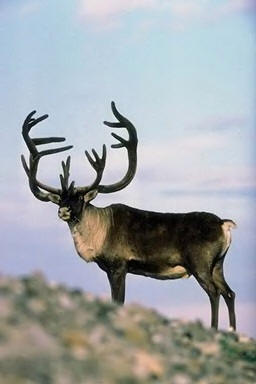 |
|
|
Photo: CoyoteThe coyote is a species of canine (like dogs) found throughout Canada with the exception of the coldest northernmost areas. Coyotes are fairly comfortable around humans and often wander into cities and towns. Coyote groups are known as pack, bands or routs. Though coyotes have been observed to travel in large groups, they primarily hunt in pairs. Typical packs consist of six closely related adults, yearlings and young. Coyotes are mainly nocturnal (hunting at night) although they can often be seen roaming around during the day. |
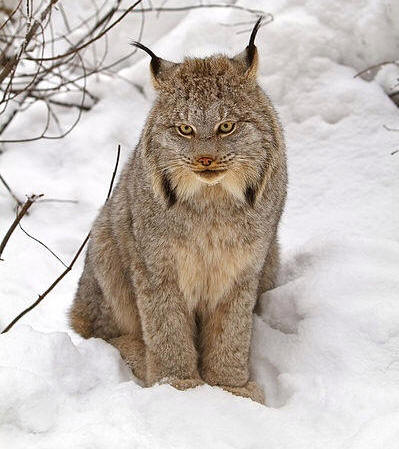 |
Photo: LynxLynxes are wild cats that can be found in boreal forests across Canada. They make their dens underneath fallen trees, tree stumps, rock ledges or thick bushes. The long, round feet of the lynx act like snowshoes by distributing their weight to help them walk on top of the snow. They also have sharp claws that retract helping them to climb, fight predators and capture prey. Their feet are covered in a thick layer of fur to keep them warm in the winter. Lynxes have dark tufted ears and short, dark bobbed tails. |
|
Photo: Moose Moose are found in every province of Canada. Despite their long skinny legs, they are powerful swimmers, enjoy eating vegetation from the bottom of lakes and are typically found living near bodies of fresh water. Even a newborn moose is capable of swimming within a few days of its birth. Moose don't have very good eyesight, but they have excellents sense of smell and hearing. The moose is the largest member of the deer family, and stands taller at the shoulder than the largest saddle horse. Moose information and coloring page |
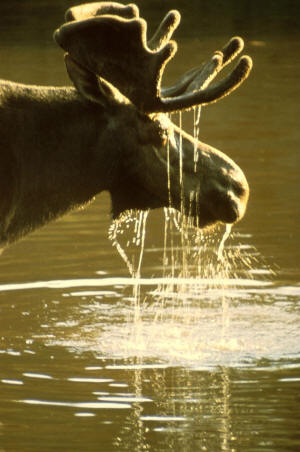 |
|
|
Photo: Polar Bear The polar bear lives in the Arctic terrain in vast areas of ice surrounding open water. It uses the ice as a platform to hunt seals. It is the world's largest land carnivore. The polar bear is an excellent swimmer and individuals have been seen in open Arctic waters over 300 km from land. With its body fat providing buoyancy, it uses it's large front paws to dog paddle through the water. Manitoba is the province with the largest polar bear population. Churchill, Manitoba has a number of organizations that offer "arctic safaris" to see these exciting animals. Polar Bear information and coloring page more about the Polar Bear > |
Photo: PorcupinePorcupines are rodents with a coat of sharp quills they use as a defense from predators - although they prefer to run away (or even climb a tree) to escape whenever possible. A porcupine’s quills are actually long strands of hair that have grown together. If one is lost, it will regrow. Porcupines don't shoot their quills, but they do detach easily when touched. Porcupines may shake their body slightly to embed the quills in an attacker. The barbs in the quills expand from body heat quickly making them very painful to remove. Since attackers tend to attack with their mouths, the quills are often lodged in the tender muzzle area of predators. |
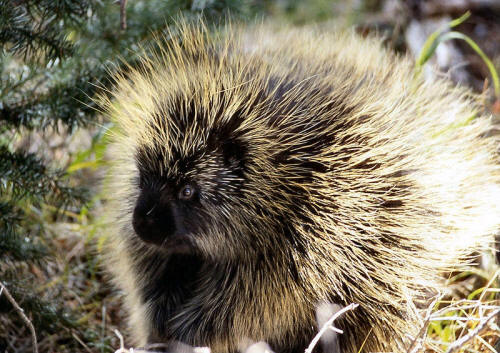 |
|
|
Porcupines live in dens found in rock piles, caves, fallen logs and trees. They eat the bark from shrubs and trees and (just like me) their favourite treat is anything salty! Porcupines are found all across North America and can be found in every province in Canada where they live anywhere there are forested areas or in shruby areas along riverbanks. And, yes, porcupine can climb trees ... They even take naps in them sometimes. |
||
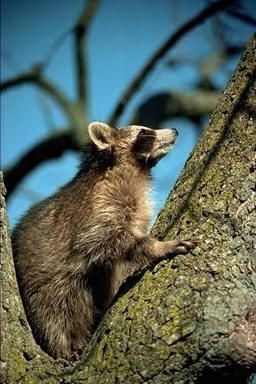 |
Photo: RaccoonsRaccoons are best recognized by the black bandit mask across their face and their big, bushy, black-striped tail. Raccoons have nimble fingers which they can use to climb, catch fish and even open garbage cans -- their paws do not have opposable thumbs and thus do not have the agility of the hands of primates. Raccoons are nocturnal, which means they feed at night. They eat vegetation, insects and small animals. They can live anywhere there is an access to food and water making them very versatile animals. However, they are best suited to living in swamps, marshes and floodplain forests. |
Photo: Striped SkunkSkunks are best recognized by the white stripes on their black body and tail and of course, their smelly smell. I think the little white stripe above their nose is pretty cute. They use their scent glands to spray a foul smelling musk for to protect themselves. The spray of a skunk can reach up to six meters and the horrible smell is strong enough to be carried almost one kilometre by the wind. Skunks prefer open areas of mixed forests and grasslands, typically living in dens abandoned by other animals. They can also live under porches - including ours! If you ever want to get rid of a skunk, just leave lights on near their den during the night. Skunks are nocturnal animals and don't like porch lights *grin*. Skunks live throughout Canada, spending the winters sleeping in deep dens. |
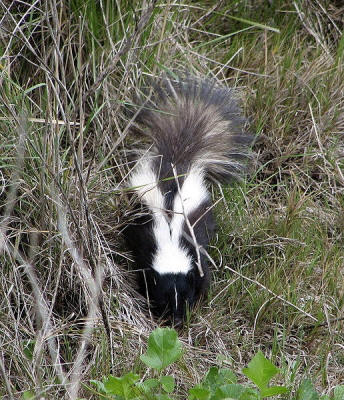 |
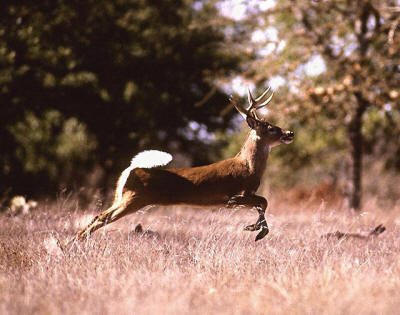 |
Photo: White-Tailed DeerThe white-tailed deer is the
most common of all of North America’s large mammals and can be
found throughout Canada. They prefer grasslands to forest - the
clearing of land for agricultural purposes is favourable for
them. |
Photo: WolvesWolves are the largest wild member of the dog family. Although they have been exterminated from many areas of the world, wolves can still be found throughout the northern regions of Canada. Wolves can still be found in the wilder parts of Manitoba including the Grey Wolf and the Timber Wolf (also known as the Eastern Canadian Wolf). Riding Mountain National Park and Whiteshell Provincial Park both have resident populations of wolves and park interpreters can tell you more about where best to listen for them - although you may hear them, it is unlikely that you would ever see them. Wolves live in packs of up to ten members which always have an alpha male and breeding female. Much of the wolf packs "play" takes place to reinforce the hierarchy of the group – very little real fighting occurs within the pack. Wolves work together as a pack to catch prey they would not be able to hunt alone. This cooperation them dangerous and effective predators. |
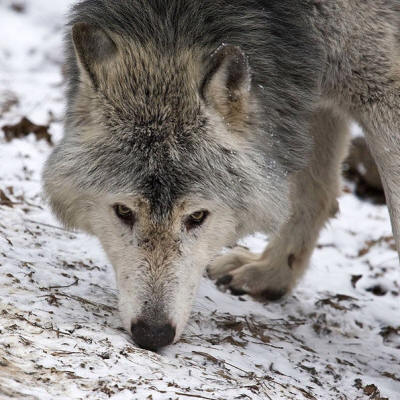 Timber Wolf photo by Christian Mehlfuhrer |
